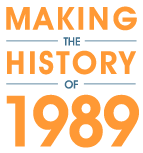Scholar Interviews
Questions
- What are your personal memories of 1989?
- How do you help students make sense of 1989?
- Which explanation for events in 1989 is most compelling?
- Why was there a communist/socialist return to power in Czechoslovakia?
- What is communism?
- What sources do you use to teach 1989?
- What else is significant about the Declaration of the Creation of Charter 77?
- How did the regime respond to Charter 77?
- Why is the 28th of January remarkable?
- How do you put the anti-Charter into context for students?
- How do you use the Charter Declaration and the anti-Charter together with students?
What sources do you use to teach 1989?
Transcription
The first source I have is the Manifesto or Declaration of the Creation of Charter 77, the Czechoslovak Dissident group’s manifesto proclaiming that they are in existence. And this was written in late 1976. The proximate cause for it was the trial of some young musicians, the Plastic People of the Universe who were put on trial in the late summer of 1976. And Vaclav Havel, who’s the primary author of the Charter 77 Declaration, attended this trial along with a large number of other dissidents. Some were reform communists in 1968, some had never been members of the Party. Some were artists, some were musicians obviously. Some were religious people in the religious community and Havel writes about this in a short piece he calls “The Trial” with obvious shadows of Kafka lying over it in which he talks about how all these various people came together and they realized that this was something actually important.
The Plastic People of the Universe were put on trial for disturbing the peace. It was actually a trial of two members of The Plastic People and two members of another band called DG 307 and they were put on trial, not because their lyrics are political, but because they were sort of long-haired weirdoes. They didn’t fit in with the communists— with what the communists wanted to see. So the communists arrested them because they had the power to do that and what Havel and others noticed at this trial was number one, that the Plastic People who— the musicians turned the tables on their accusers and accused them of bad behavior and acting contrary to the laws and these kinds of things. And the second thing that Havel noticed was that at this trial, these people defending them came together with what I’d like to call the least common denominator of protecting human rights and artistic rights.
The Charter’s an interesting document, very symbolic I think of its times. In the English translation, it’s about five pages long so it’s not a terribly long document, but the first three of so of those go on to list the laws that the communist government has on its own books, but also the laws that were brought into the Czechoslovak legal code as a result of the regime signing the Helsinki Final Act which had happened in 1975. The Helsinki Final Act is a turning point in the way in which I think oppositional movements or oppositional figures thought about the regimes.
As I pointed out earlier, Reformist Marxism was the language that people used until 1968 and then they went off sort of into the wilderness looking for a new language and Helsinki provided them with that language. It was the language of human rights. The least common denominator; it can bring everyone together. So the first two-thirds, roughly, of the document deal with the systematic abuse of the rights that are guaranteed under Czechoslovak law and are guaranteed under the international covenants of various sorts dating back to the International Covenant on Human Rights.
Legalism I think was important to them and it functioned in a couple of important ways. Number one, by stressing legality. They are not claiming anything that isn’t already there, so not demanding anything from the regime that the regime hasn’t already promised to give them. And related to this, a sort of corollary to it, is it seems a primarily defensive kind of stance. We’re not attacking the regime. We’re merely defending ourselves and the principles that the regime claims to stand for.
Finally, by this sort of legalism, it put the regimes on the defensive. They either had to live up to the rights that are enshrined in their legal code, or they have to admit that they’re not going to. And this could be potentially very damaging because one of the things about the Helsinki Final Act is that it provided for international supervision of human rights and this in its turn was important because these regimes, not just in Czechoslovakia, but in other parts of Eastern Europe as well, were in the process of borrowing large amounts of money from the west and if they were seen to be miscreants in human rights behavior, it’s possible that they could lose the trade benefits that come along with it.
This was magnified by the fact that Jimmy Carter was our president in 1977 and here we had a president who took human rights quite seriously. So I think the legalism was an important part of this as it was an important part of something like the Committee to Defend the Workers in Poland or the later the Committee to Defend the Unjustly Persecuted in Czechoslovakia that legalism was the sort of jumping off point for this.
How to Cite
Bradley Abrams, interview, "What sources do you use to teach 1989?" Making the History of 1989, Item #623, https://chnm.gmu.edu/1989/items/show/623 (accessed May 28 2021, 3:24 pm).
